What Hi-Fi? Verdict
These Audio Pros have all the right ideas, but there's just not enough in the audio performance for a hearty recommendation
Pros
- +
Excellent connectivity options
- +
Strong multi-room ecosystem
- +
Big sound for size
Cons
- -
Lacking drive and dynamics
- -
Unsophisticated midrange
- -
Expensive
Why you can trust What Hi-Fi?
The Audio Pro A26 powered speakers are the first standmounters the Swedish company has added to its popular multi-room range. Alongside the A36 floorstanders released at the same time, they break new ground as the first dedicated stereo pair in the series.
Armed with an impressive array of connectivity, including an HDMI ARC input to turn them into speakers for TV sound, the A26s are positioned as an all-round sound system for the living room.
They are fitted with the latest low latency Bluetooth codec, Spotify Connect, the Audio Pro app featuring all the major music services and networked streaming abilities. On paper, at least, the A26s have more or less everything you could wish for.
Build
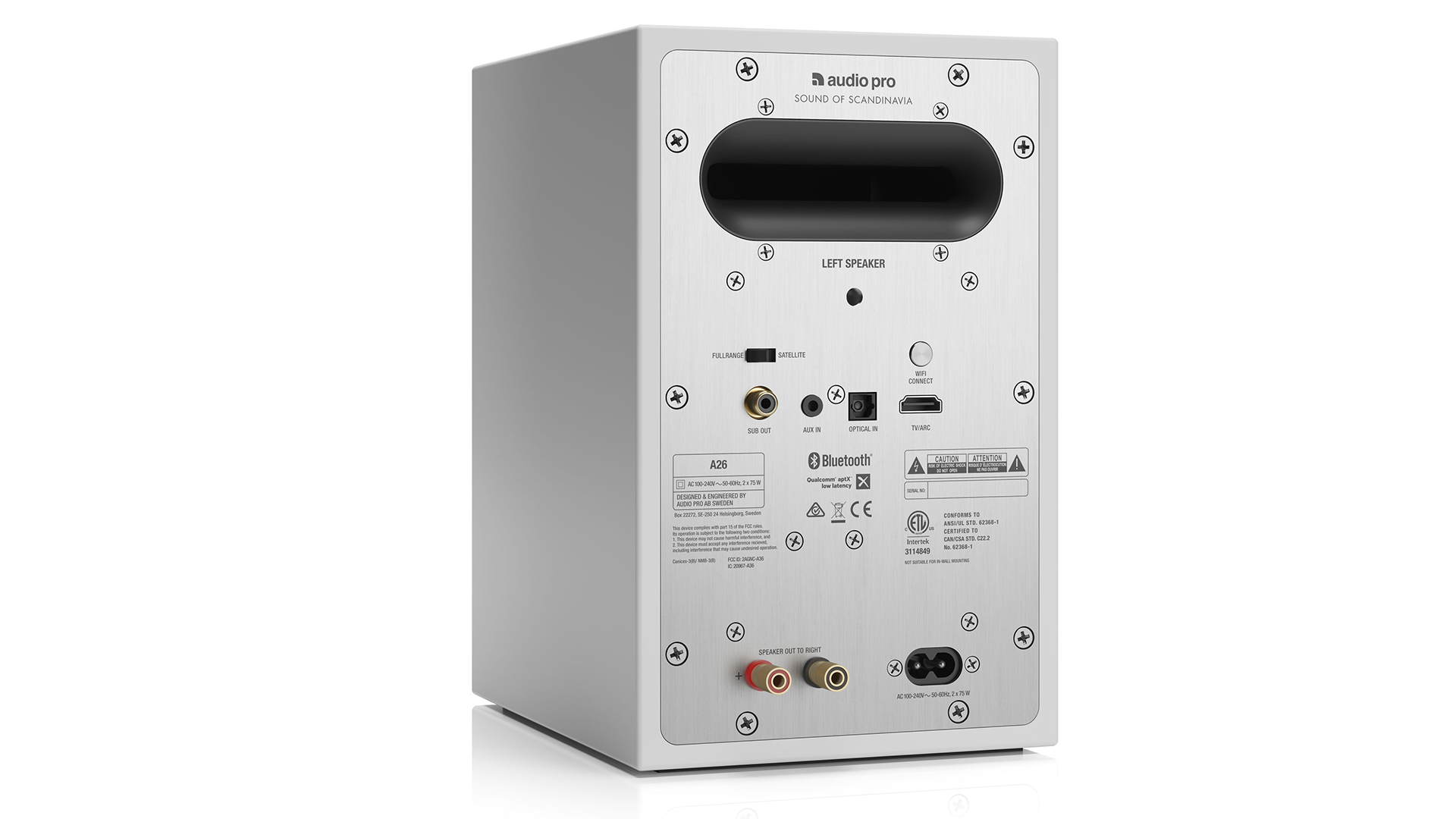
The A26s are a design departure from the Addon range, which has featured the same, koala-like face for years. The new aesthetic is not terribly exciting, though.
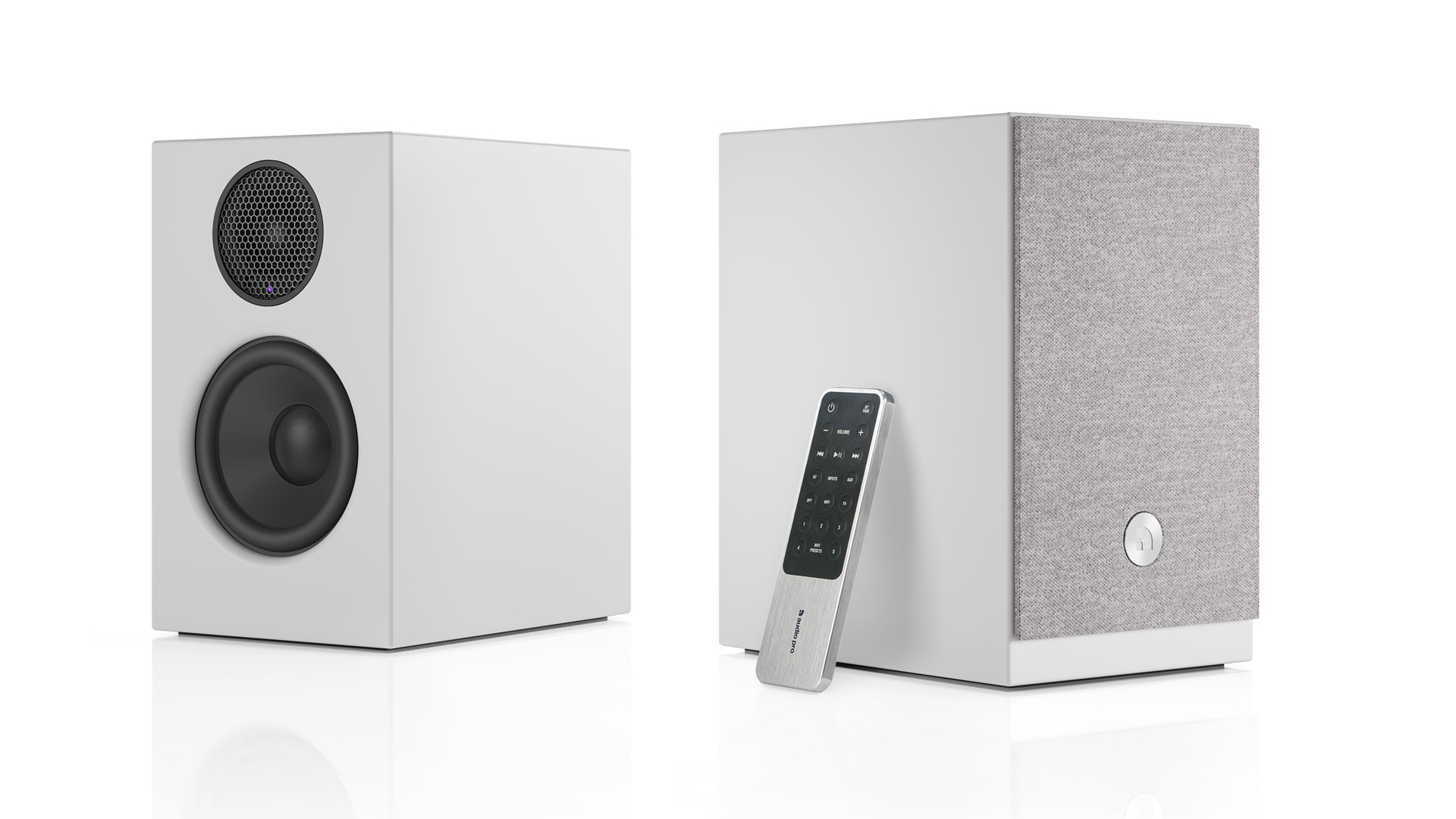
Bluetooth version 5.0 aptX
Inputs HDMI ARC, optical, aux-in, wi-fi
Tweeter 2.5cm textile dome
Woofer 11.5cm
Power 2x 75W Digital Class D amplifier
Spotify Connect Yes
Finishes x2 (White/Black)
Rear-ported Yes
Dimensions (hwd) 23.8 x 15 x 20cm
The charcoal covers feature a metal Audio Pro logo but, apart from that, there are only smooth surfaces. Remove their grilles and our black review sample looks rather plain on the eye, though the alternative, white finish has a more classily Scandinavian look.
The two drive units are also black. On top is the 25mm textile dome tweeter with the 11.4cm woofer on the bottom. Inside one of the rear-ported boxes is a pair of 75W Class D amplifiers – one drives the master speaker and the other is for its passive partner. The two speakers are connected by an included speaker cable.
Connectivity includes Bluetooth 5.0 aptX, optical, HDMI ARC and an analogue aux. There’s also an RCA subwoofer connection in case you'd like to add some extra bass.
Audio Pro makes a set of dedicated wall brackets that costs a fairly reasonable £29 per pair. The A26s work best when placed close to the wall, so these brackets should help the speakers deliver something approaching their optimum sound.
Compatibility
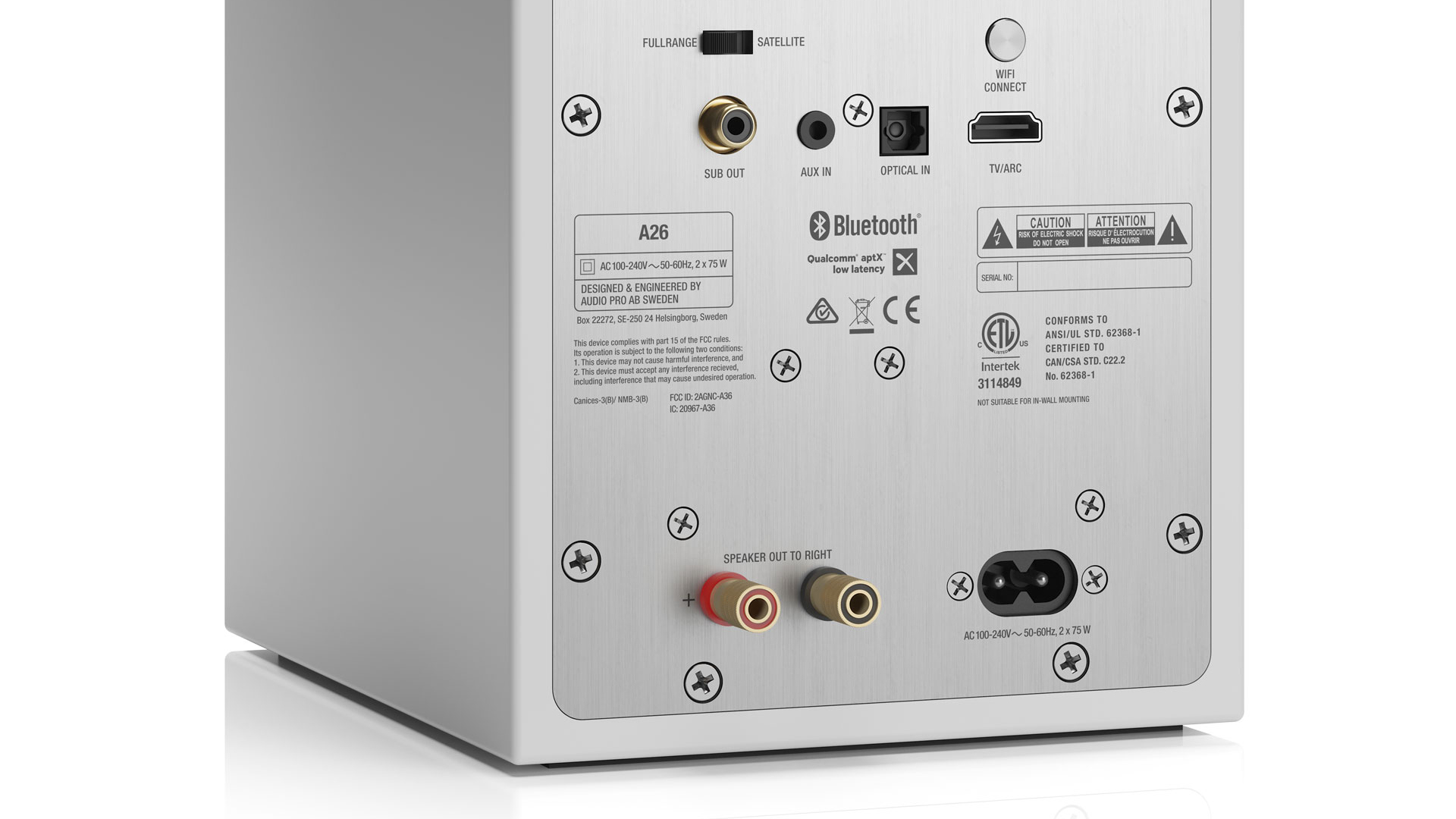
You can leverage all the wireless potential of the A26s through the Audio Pro Control app, which integrates the likes of Tidal, iHeartRadio, Napster, Qobuz and Deezer in one place. You can play any locally stored audio files, including podcasts, through the app as well. The A26 speakers also work with Spotify Connect.
The Audio Pro app itself is a little rudimentary compared to some, but also fairly well thought out. It's responsive and not over-complicated, which is important if you’re using the A26 as part of a larger Audio Pro multi-room set-up.
There is a straightforward EQ control in the form of bass and treble sliders, although these are generally best left flat. There’s also an audio virtualiser mode to help create a soundstage especially for movie-watching and a night mode to enhance dialogue clarity while keeping the main volume and bass as low as possible.
You won’t find all of those options on the dedicated remote control, though. This pleasing aluminium zapper offers volume, input selection and playback controls, but these won’t necessarily work for every single source device. For example, it doesn’t skip tracks when plugged into our laptop playing FLAC files through VLC.
Sound
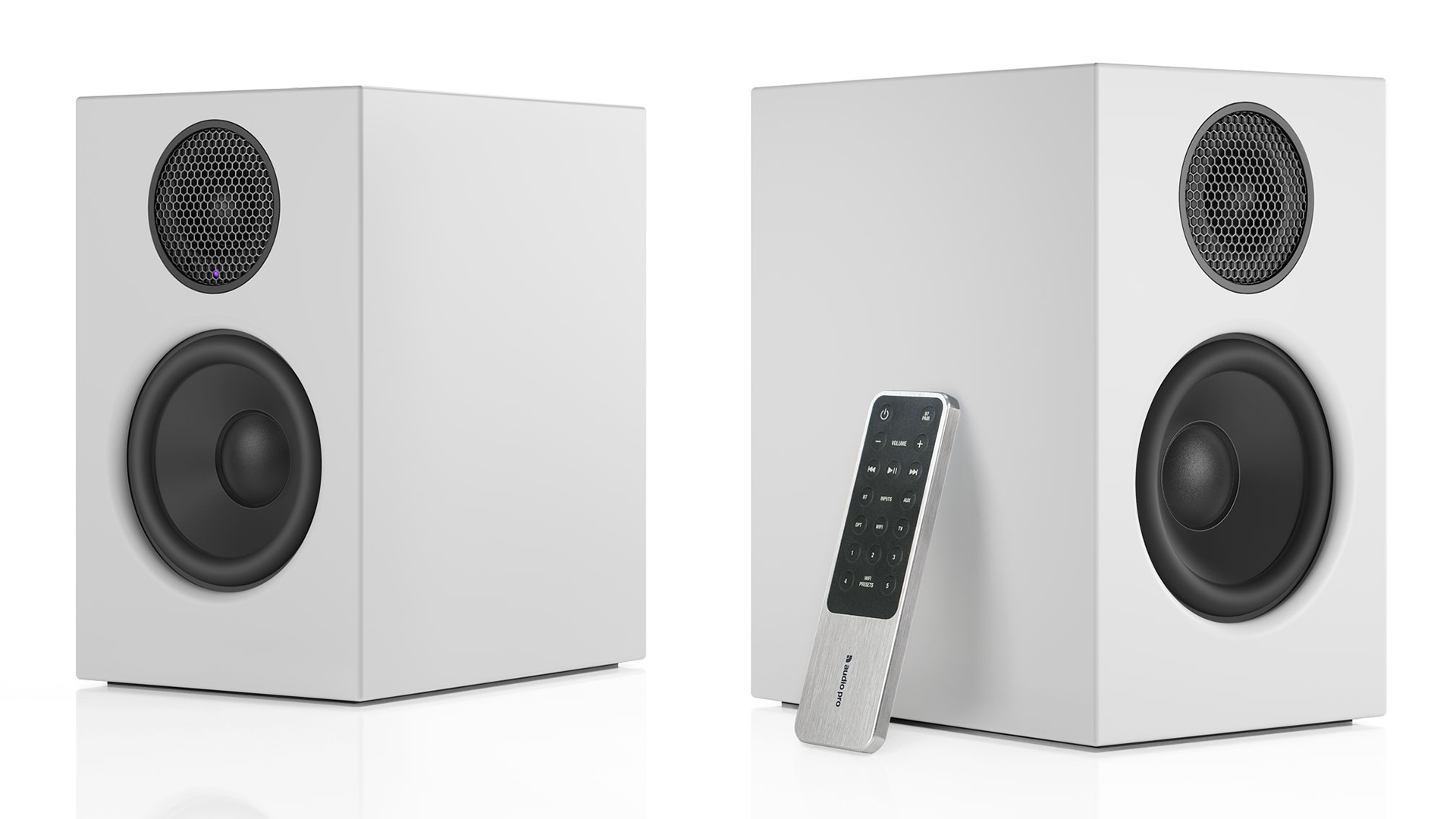
We start with Mozart’s Violin Concerto No.3 In G Major, K.216, and get an immediate feel for the space and scale that this two-speaker solution offers. There’s an impression of openness with a soundstage that’s broad enough to deliver a strong sense of the orchestra.
The audio is still centred on where the speakers sit, but there’s enough to get a clear idea of positioning of the first violin in the foreground and the rest of the string section behind and to the right.
The dynamics are decent, if not inspirational. The sound doesn’t drop down to a deep silence but there’s a clear difference in the scale between the first violin fiddling away to the tune compared to the rest of the strings bowing out the bed of music in the background.
We play something a little faster with Radio Free Europe by R.E.M on FLAC, played hard wired to the A26s, and we’re immediately impressed with the size of the sound for such little speakers. The kick drum is like a heartbeat thumping through the track from first to last.
It’s not a long way off a room-filling performance and certainly enough to feel the bass in our bodies. However, it’s a soft-edged sound, missing the precision to convey a good sense of the pulse of the music.
There’s a reasonable tonal balance to the track. Michael Stipe’s voice is clear and there’s plenty of detail including the wangling guitar that drops in and out of the song.
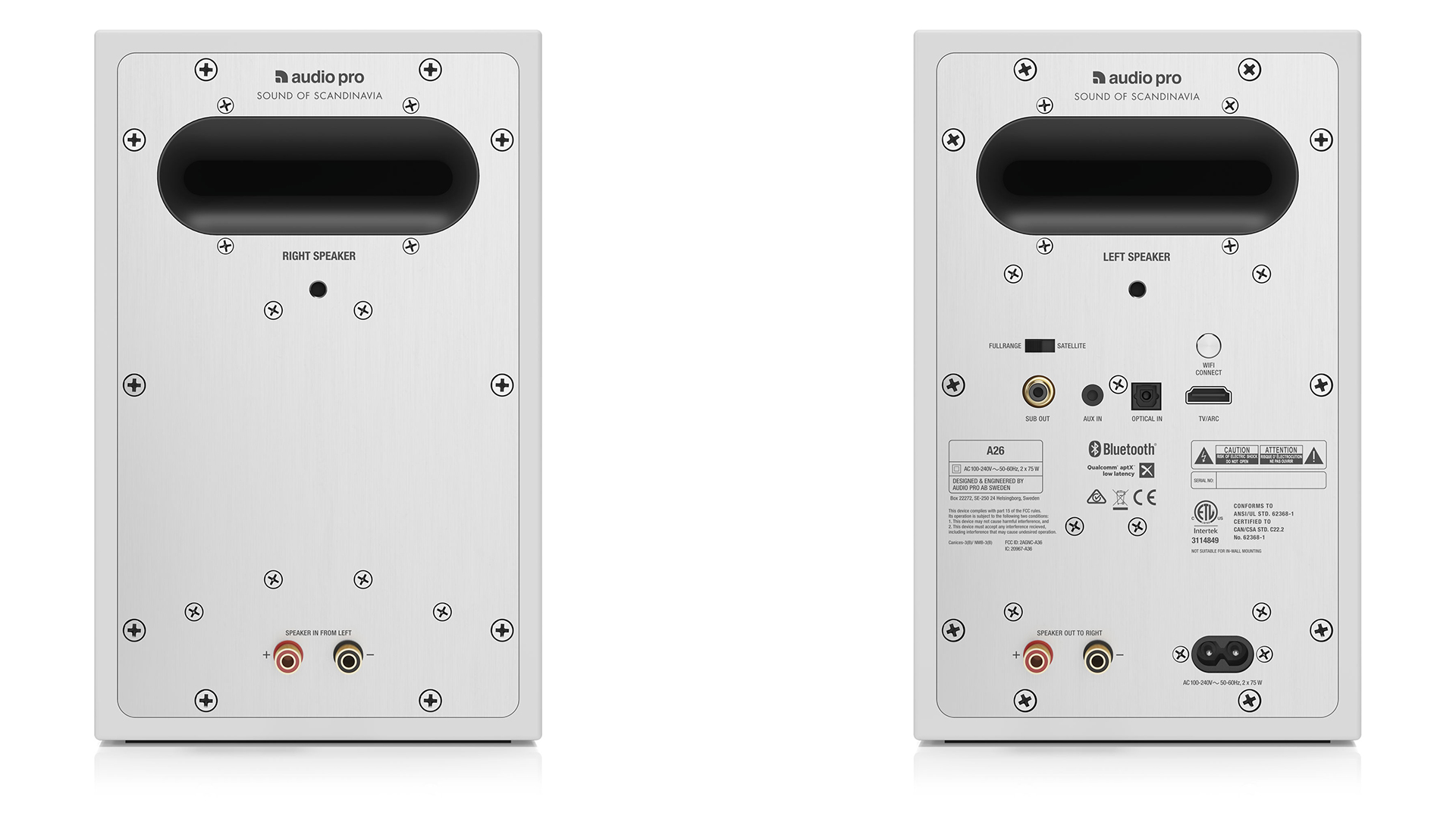
Right at the top, there are plenty of sounds from the metal parts of the drum kit but they’re not sounds we particularly enjoy. The treble notes are unsophisticated and the tweeter sounds too messy. The hi-hats, the snares and the cymbals are hard to differentiate, which rather spoils the pleasure of Bill Berry’s work.
What really kills the track, though, is its lack of rhythmic drive. The A26s struggle to create a definite onset and end of notes to mete out a sharp, clear sense of purpose to every strum or percussive hit.
Combined with the less than stellar dynamic ability and soft bass, it makes for a murky and disappointing climax to the track. That becomes quite hard on the ears when listening to a whole album of songs with attack.
We take it down a gear with Respect by Aretha Franklin and the speakers respond well to this less complicated recording. The track is simple and staccato enough to hold a better sense of purpose. It’s enjoyable enough and there’s an even balance of the guitar with the lead and backing vocals. All the same, the feel of the song isn’t quite translated.
There’s not enough expression in the midrange for us to appreciate anything like the depth and desire of Franklin’s demands of her lover. Not even the normally dripping rich ‘oohs’ of the backing singers carry much nuance.
Verdict
These Audio Pros aren’t a bad pair of wireless speakers – they are easy to set up; they can work for both your music and your TV sound; and they are capable of working in a multi-room set-up. They support just about every kind of input and you can use pretty much any music streaming service with them.
The trouble is that they just don’t sound that great. If a pair of speakers doesn’t make you excited about listening to music, they have fallen short in their primary purpose.
If you’re already heavily invested in the Audio Pro ecosystem, you might wish to try them out, but we’d advise you to spend your money elsewhere and buy something more musically talented, such as the Ruark Audio MR1 Mk2s.
SCORES
- Sound 3
- Compatibility 5
- Build 5
MORE:
Read our Ruark Audio MR1 Mk2 review
What Hi-Fi?, founded in 1976, is the world's leading independent guide to buying and owning hi-fi and home entertainment products. Our comprehensive tests help you buy the very best for your money, with our advice sections giving you step-by-step information on how to get even more from your music and movies. Everything is tested by our dedicated team of in-house reviewers in our custom-built test rooms in London, Reading and Bath. Our coveted five-star rating and Awards are recognised all over the world as the ultimate seal of approval, so you can buy with absolute confidence.
-
Swimming Does anyone else have experience with the sound of these? I find it hard to believe that the C10/C5/C3 all win awards for their sound but the A26s sound so bad. It's a shame if they do as I'm struggling to find wifi enabled separate active speakers around this price. The KEF LSXs get good reviews but they're twice the price.Reply -
nopiano Reply
I haven’t, but I’m a satisfied user of the previous generation of portable wireless speaker, the Allroom Air One. Unfortunately I have come across the occasional dud in a range.Swimming said:Does anyone else have experience with the sound of these? I find it hard to believe that the C10/C5/C3 all win awards for their sound but the A26s sound so bad. It's a shame if they do as I'm struggling to find wifi enabled separate active speakers around this price. The KEF LSXs get good reviews but they're twice the price.
Is it active or wireless that you really need? There are lots of powered speakers at lower prices, and the KEF are fairly often discounted or available on eBay as ex-dem or used. -
Swimming Reply
Thank you for taking the time to reply, much appreciated.nopiano said:I haven’t, but I’m a satisfied user of the previous generation of portable wireless speaker, the Allroom Air One. Unfortunately I have come across the occasional dud in a range.
Is it active or wireless that you really need? There are lots of powered speakers at lower prices, and the KEF are fairly often discounted or available on eBay as ex-dem or used.
Do I want Active or Wireless? I'm not sure. I'm working from home and listening to Spotify all day on a Sony RDP XF300ip (40w, 150 - 10000 Hz, Drivers are 25 mm, 76 mm). I would like something which sounds significantly better which can also play Spotify Connect (so I can use my phone while music plays) and radio.
I've read that a single unit will never sound as good as a pair of speakers, and I want something which can occasionally be moved to different rooms without much hassle. The Audio Pro A26s tick all these boxes, and I've seen them for £455, which is almost the top of my budget. Are there any other options which would meet my needs? -
nopiano Reply
I’m afraid this isn’t my specialist subject, though I’ve heard of folks who get good results with a pair of Sonos Play 1. Their newer models might be pair-able for stereo too, but I don’t know.Swimming said:The Audio Pro A26s tick all these boxes, and I've seen them for £455, which is almost the top of my budget. Are there any other options which would meet my needs?
I don’t think the Addon range can be, though they do multiroom. Even the costlier Naim Muso models are one box.
More options here...https://www.whathifi.com/best-buys/best-wireless-speakers-wonderful-wi-fi-speakers-for-all-budgets -
dariom79 You can just get two C3s, C5s or C10s and set them up as left/right.Reply
I have two C5As set up like this with a subwoofer, not incredibly happy with the sound (I think they lack midrange, sound a bit "dry") but it definitely works neatly. -
Allan Rosenzweig Reply
I own a pair of these. Personally I disagree with the review. I own lots of high end equipment like Krell and McIntosh gear as well as B&W and Martin Logan speakers. For a small to mid-sized room, these sound excellent with music. Mids are smooth. Back off 1 notch on the treble for the smoothest vocals. These are great for jazz, New Age, vocals, and small orchestras or quartets. Very good for a bedroom or home office or den.Swimming said:Does anyone else have experience with the sound of these? I find it hard to believe that the C10/C5/C3 all win awards for their sound but the A26s sound so bad. It's a shame if they do as I'm struggling to find wifi enabled separate active speakers around this price. The KEF LSXs get good reviews but they're twice the price. -
Erwanitis I don't know about the quality of the A26 but several reviews talked about a kind of constant breath coming out from these speakers, although they seem globally rather good (read in the conclusion of this, in French sorry, for instance). Maybe it could be an idea to avoid listening while being too close to them.Reply
As far as I am concerned I own the little bigger sisters, the A36 loudspeakers, and they rock. I am surprised -and disapointed- that Whathifi did not review them too yet, I am truly convinced they are a very interesting alternative to soundbars and that they could also perfectly be used to listen various kinds of music. A common drawback is the quality of the Audio Pro app, which is not very handy as a playlists' builder, so I frequently make my playlists on another Android app (BubbleUPnP). But the Audio Pro app is slowly improving.

